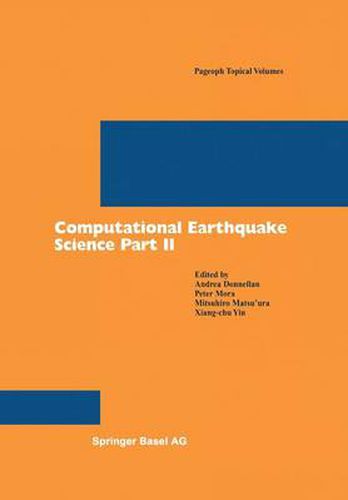Readings Newsletter
Become a Readings Member to make your shopping experience even easier.
Sign in or sign up for free!
You’re not far away from qualifying for FREE standard shipping within Australia
You’ve qualified for FREE standard shipping within Australia
The cart is loading…






This title is printed to order. This book may have been self-published. If so, we cannot guarantee the quality of the content. In the main most books will have gone through the editing process however some may not. We therefore suggest that you be aware of this before ordering this book. If in doubt check either the author or publisher’s details as we are unable to accept any returns unless they are faulty. Please contact us if you have any questions.
Exciting developments in earthquake science have benefited from new observations, improved computational technologies, and improved modeling capabilities. Designing models of the earthquake generation process is a grand scientific challenge due to the complexity of phenomena and range of scales involved from microscopic to global. Such models provide powerful new tools for the study of earthquake precursory phenomena and the earthquake cycle.
Through workshops, collaborations and publications, the APEC Cooperation for Earthquake Simulations (ACES) aims to develop realistic supercomputer simulation models for the complete earthquake generation process, thus providing a virtual laboratory to probe earthquake behavior.
Part II of the book embraces dynamic rupture and wave propagation, computational environment and algorithms, data assimilation and understanding, and applications of models to earthquakes. This part also contains articles on the computational approaches and challenges of constructing earthquake models.
$9.00 standard shipping within Australia
FREE standard shipping within Australia for orders over $100.00
Express & International shipping calculated at checkout
This title is printed to order. This book may have been self-published. If so, we cannot guarantee the quality of the content. In the main most books will have gone through the editing process however some may not. We therefore suggest that you be aware of this before ordering this book. If in doubt check either the author or publisher’s details as we are unable to accept any returns unless they are faulty. Please contact us if you have any questions.
Exciting developments in earthquake science have benefited from new observations, improved computational technologies, and improved modeling capabilities. Designing models of the earthquake generation process is a grand scientific challenge due to the complexity of phenomena and range of scales involved from microscopic to global. Such models provide powerful new tools for the study of earthquake precursory phenomena and the earthquake cycle.
Through workshops, collaborations and publications, the APEC Cooperation for Earthquake Simulations (ACES) aims to develop realistic supercomputer simulation models for the complete earthquake generation process, thus providing a virtual laboratory to probe earthquake behavior.
Part II of the book embraces dynamic rupture and wave propagation, computational environment and algorithms, data assimilation and understanding, and applications of models to earthquakes. This part also contains articles on the computational approaches and challenges of constructing earthquake models.